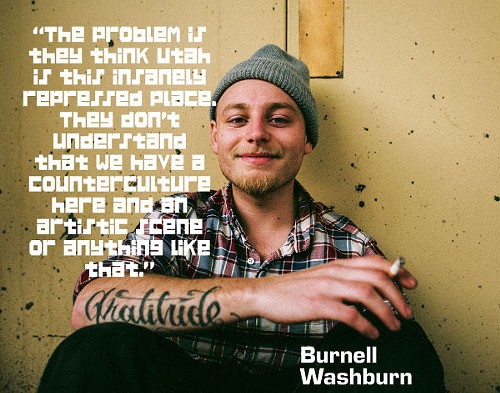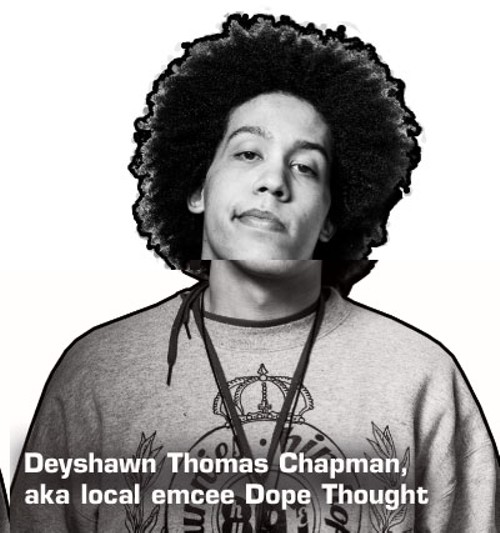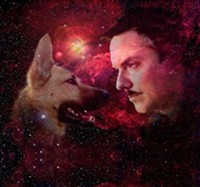Paying Dues
Local rappers make names for themselves while living in a city that doesn't always get it
By Colin Wolf @wolfcolinPage 2 of 3
Hip-Hop Is Dead
During the early- to mid-2000s, Mason became a regular fixture with Rasco’s crew, joining him on national and international tours alongside rap headliners like The Pharcyde, Souls of Mischief, KutMasta Kurt and Motion Man. But in between it all, Mason was working on his first solo album, Digitalis. On Feb. 6, 2006, the album finally dropped in stores. “I felt really good about that,” Mason says. “I was like, ‘Oh my gosh, this is really happening.’ ”
Digitalis did moderately well in the United States, but exceeded expectations in Europe.
After heavy touring overseas, and a few spot dates locally, things began to slow down for Mason—and for the music industry as a whole. Record shops were dying a slow death because of the rise in Internet album and single sales.
Everyone in the music industry suffered, but especially rap music, where DJs, typically dependent on record shops for vinyl, were switching over to MP3-based DJing.
“Once DJs stopped buying records, that was a big blow for rap music and the entire record industry,” says Chase Loter (aka Chaseone2, winner of the 2010 City Weekly Music Awards for Best DJ). “When the music industry died, the rap scene sort of died here, too.” At the peak of rap’s popularity, Salt Lake City hosted multiple record stores and hip-hop merch shops. Loter used to co-own Fourth Street Records until it merged in 2012 with Salt Lake’s last remaining hip-hop shop, Uprok, located at 342 S. State.
“There’s been a hip-hop shop in SLC for 20-plus years,” says Chase Jensen, owner of Uprok, “There used to be Brisk’s store, Funksion. Before that it was Blastin—where the Heavy Metal Shop is now. There used to be a shop over on 39th and State, one on 33rd and 13th East in some house, and there was one in Sugar House. All that shit is gone now.”
Rap From the Ashes
Not wanting to fade away, Mason teamed back up with Brisk and returned to the studio for a new album—an effort that would showcase an arsenal of big-name guest features.
A feature is when an emcee does a verse for another rapper. Depending on the how big the emcee is, or how much he respects you, getting a feature on your track can cost a lot of money. With Mason’s connections, he was able to land big names for what he calls “homie prices.”
“So Rasco calls again and is like, ‘Dude, I’m doing this mini-run out in Switzerland with Dilated Peoples, you down?’ ” Mason says. “We’re staying at this baller-ass hotel on Lake Geneva right across from France. One morning, I go down to breakfast and I see Evidence (of ’90s group Dilated Peoples, later a producer for the Beastie Boys and Kanye West) by himself, drinking coffee, eating cheese bread, you know, little European stuff.
“So me and him are talking, and finally I was like, ‘Yo, I’m doing this album, I would love for you to drop a verse,’ and he was like ‘Cool.’ I was feeling good about that, and I was about to go back to my room and he says to me, ‘Dude, you want to smoke?’ So ... we’re smoking on his balcony in his room, overlooking Lake Geneva and he goes, ‘Dude, right over there, where those mountains are … that’s France.’ I was like, ‘Daaaamn.’ We’ve been tight ever since.”
Mason, Rasco and Dilated Peoples knocked out the tour, and, five months later, in 2010, Evidence had a show in Salt Lake City with the world-famous DJ Revolution. The day of the show, Mason got the duo to join him for a recording session at Brisk’s studio, where they laid down the track “Tech Noir.”
“When a good rapper comes through [Salt Lake City] that I like and appreciate, I get verses from ’em,” Mason says.
Through this method, Mason was able to land impressive names like Action Bronson, Fashawn, Brand Nubian, Guilty Simpson and Statik Selectah. “It was pretty fun hanging out with some of these guys when they were in town because you’re like ... doing stuff no one else is doing right now,” Mason says.
After enough legendary rappers and producers had passed through Brisk’s basement, the album was ready, but it hadn’t yet been signed to a major distribution company. So, in 2011, while on a trip to New York City, Mason’s friend DJ Juggy dropped off snippets of the album with his industry friends at Duckdown Records, Hot97 and Soulspazm. On Valentine’s Day 2012, Mason signed a digital distribution deal with Soulspazm. The following November, his second full-length album, Kobain, was released. The debut single, “Octopussy Tentacles,” featuring Action Bronson, reached No. 1 on the College Radio charts.
“I have people come up to me here and say, ‘Dude, that’s probably the best hip-hop album that ever came out of Salt Lake City,’ ” Mason says. “And I’ve also heard people tell me it doesn’t sound like something that should come out of here.”
It’s Not Easy to Rep SLC
Rap music has always been prideful about representing a local scene. But because of Mason’s good fortune, he’s never had to tell anyone he lives in Salt Lake City. He almost never drops a Utah reference in any of his songs, and his beat production, mostly by Brisk, feels more at home with ’90s East Coast hip-hop.
His popularity grew from the outside of Utah’s borders rather than from within, so Mason has never had to keep a presence here, or even throw shows on a consistent basis. This anonymity allows Mason to exist in rap music on a popular level and not actually have a city to rep.
It’s hard to blame Mason for this disconnect. In Utah, there’s no cultural cachet when it comes to rap music. There’s no history. When a rapper says he’s from the Bay Area, it conjures up thoughts of 808 drums and hyphy music. When a rapper says he’s from Utah, you can probably guess what the next question is.
“I did some gigs not too long ago at a club in Vegas,” Brisk says, “and the manager asked me ‘Where you from?’ I was like, ‘I’m from Utah,’ He was like, ‘Oh, you Mormon?’ I mean, every time you go out of state and you say you’re from Utah, that’s more than likely the next question you’re going to get.”
“The problem is they think Utah is this insanely repressed place,” says Stu Sheffield, aka rapper Burnell Washburn. “They don’t understand that we have a counterculture here and an artistic scene or anything like that.”
The Sandy-based Sheffield, 22, has cultivated a sound that could be described as jazz-influenced conscious hip-hop—politically charged rap with a message, like his 2012 track “Occupy Salt Lake.” It’s a stark contrast to the gangster-rap sounds of the Salt Lake Valley’s west-side neighborhoods. This variation in styles has caused the Salt Lake’s scene to suffer from an almost comical identity crisis.
Up-and-coming 21-year-old Rose Park emcee Deyshawn Thomas Chapman, aka local emcee Dope Thought, grew up breakdancing and started freestyling at 17. “I never really was into rap music because of the gangster-rap stuff that I grew up around in Rose Park,” he says. “I basically realized I could do this stuff in a positive, uplifting way, rather than in a negative, degrading way.”
He started his own music collective called MakeMind, which brings together underground artists from around the country. He released his first industry-level album, We Are Environment, alongside local producer Worth, and is currently working on a single with rap royalty Talib Kweli.
Despite those successes and air time on local independent radio station KRCL, Chapman is yet to see radio play on a bigger level because his progressive rap isn’t what Salt Lake City rap fans expect to hear on a station like U92.
“The problem is a lot of the kids who are rhyming about gangster rap are mostly white kids, and that’s fine,” Chapman says. “But Salt Lake isn’t a gangster scene. When you try to rap like a gangster and you live in a city that isn’t, that’s where it’s hard for you to go outside the borders and be taken seriously.”
This has been Concise Kilgore’s issue all along. Arguably Salt Lake City’s most successful rapper, Mason has refused to work with the majority of rappers from Utah.
“If you’re just doing the same old thing and you’re copying who is hot on the radio or TV, you’re not gonna make it,” Mason says. “It’s just not gonna work. ... Being a rapper in Salt Lake, you gotta think bigger. You can’t pigeonhole yourself into a scene that isn’t quite there.”
Professor John Costa, who teaches a course on rock & roll history at the University of Utah, says the reason Utah artists have trouble winning over fans might be that they just don’t know how.
“Salt Lake musicians lack access to great management,” Costa says. “That’s what all great artists have in common. Russell Simmons was the guy behind the Beastie Boys and Run DMC; he had a wealth of connections to people before he even started Def Jam. People like him open doors for their artists. The Beatles would have never been anything without Brian Epstein. You know, these background people can be more important than you think.”
More by Colin Wolf
-
Catching Up With DJ Matty Mo
2014's DJ of the Year is keeping the good kind of busy
- Jan 7, 2015
-
Best Local Rap of 2014
Utah-released hip-hop you shouldn't sleep on
- Dec 31, 2014
-
There's a Michael Jackson tribute band in Park City tonight
- Dec 29, 2014
- More »
Latest in Cover Story
Readers also liked…
-
Forget the family pedigree—Robert F. Kennedy Jr should not be the next president of the United States
Trojan Horse
- Jun 21, 2023
-
Women decry harassment and toxic culture at St. George auto dealership
Men at Work
- Oct 11, 2023






